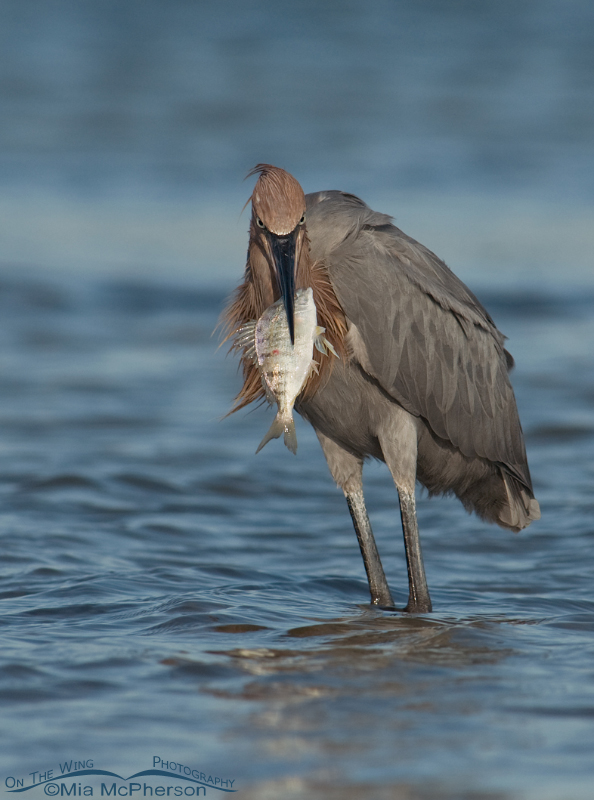I photographed this Reddish Egret (Egretta rufescens) in October of 2008 at Fort De Soto’s north beach. At that time I was sitting in the water taking images of Great Egrets and some Laughing Gulls when the egret flew in and began fishing in the warm, shallow lagoon. It didn’t take the bird long to catch this fish.
 Reddish Egret lunch time – Nikon D200, handheld, f7.1, 1/800, ISO 250, Nikkor 80-400mm VR at 400mm, natural light
Reddish Egret lunch time – Nikon D200, handheld, f7.1, 1/800, ISO 250, Nikkor 80-400mm VR at 400mm, natural light
The other birds in the area appeared to be quite interested in the egret’s prey and the egret had a difficult time swallowing it but after about 5 minutes it was finally able to do so. The prey is swallowed head first so those sharp spines of the fins are compressed.
There are only between 1,500 and 2,000 nesting pairs of Reddish Egrets in the United States and their numbers are being threatened by habitat destruction. I’m sure their population also took a dive after the Deepwater Horizon oil spill since they are primarily a coastal wading bird and are found along the shorelines of Florida, Alabama, Mississippi, Louisiana and Texas, all of which were impacted by the oily sludge that coated the surface of the Gulf of Mexico, the beaches, marshes and tidal lagoons. And oil companies want more drilling platforms in the Gulf?
I think the CEO’s of the huge oil companies that have caused spills should have to live with oil surrounding their fabulous mansions and forced to raise their families in the same horrible conditions that the birds and other wildlife have been subjected to, perhaps they would be more careful. I can dream, right?
*I am away for a few days, please feel free to share this post with your friends and family. I’ll catch up on everyone’s great blogs when I get back!
Mia


Awesome capture Mia, love the detail and color:)
Thank you Susan!
I like the head-on pose. Most these egrets are in the top predator food chain, so with each oil spill they become the most reliable source of damage done in the environment. And so happens with all top food-chain predators. They must inevitably accompany humans in the treacherous path of co-existence on earth, much of course, to their disadvantage and destruction of their natural habitats.
It is my hope that one day we will no longer have oil spills because oil companies will go above & beyond the safety measures & laws to protect wildlife. Well, I know I can dream.
Great shot Mia and i like your idea for the oil tycoons. I hope to someday see one of these gorgeous birds.
I hope you get to see & photograph some Reddish Egrets Dan!
Mia, this is a fabulous photo..I believe the CEO’s should have to shower with oil slick water and see how it feels. Our wildlife is so precious and we have not been very good stewards of the land. It breaks my heart to see the abuse the oil companies have caused all for the almighty buck. Thanks so very much for your contribution of sharing your photos with all of us.
Thank you very much Syl!
Mia, I’ve only worked one oil spill event (in SF Bay), but I’ve had precisely the same thought. Whenever anyone, politician or other, gets on the drilling bandwagon and dismisses the environmental effects, I wish I could somehow force them to grasp, viscerally, the intense suffering endured by these animals. Seeing it even on a comparatively minute scale crushed a piece of my heart forever.
I think if the company or persons who cause oil spills had to walk around covered in oil, with the greasey sludge on their food and the surface of their water they might be more careful or at least aware of the problems oil spills can cause. Thanks for commenting Ingrid.
Gorgeous photo, Mia.
Thanks Bob!
He’s magnificent. So beautiful. Carol
Thank you very much Carol.
Love the colors in this shot, and great detail on the fish he caught. Definitely has a ‘dont mess with me’ glare too
Yeah, I didn’t want to mess with the egret’s fish Stu!